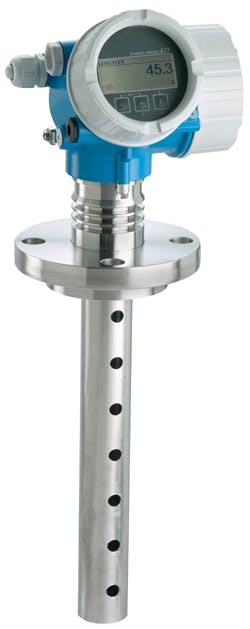Level Transmitter Uses Capacitance And Guided Wave Radar Technologies
Endress+Hauser's Levelflex FMP55 multiparameter level transmitter can measure both the overall level of a liquid and the interface between two liquids. The FMP55 utilizes two level technologies built into one probe. The transmitter will automatically switch between the technologies in order to provide an interface measurement, even in the presence of emulsion or rag layers. The use of two technologies can eliminate many problems associated with interface level applications.
Capacitance is not affected by emulsion or rag layers in interface applications, and the radar allows the transmitter to monitor the overall level as well as the interface level. The transmitter has a multi-echo tracking algorithm that can track up to 20 tank echoes simultaneously as the tank level rises or lowers. This ensures that the transmitter will not make a "jump" to an echo that is not the true level, such as a internal tank obstruction or heater coils. The level sensor has a measuring range of up to 33 ft (10 m). The transmitter offers a 4-20mA with HART output signal plus an optional second 4-20 mA output
With its coated multiparameter probe, the FMP55 is suitable for interface measurement in the oil, gas and chemical industries. It can be used in process temperatures from -58 to 392 degrees Fahrenheit (-50 to 200 degrees Celsius) and in pressures from -14.5 to 580 psi (-1 to 40 Bar). The FMP55 carries a SIL 2 rating as certified by TÜV per IEC 61508 and has ATEX, IEC Ex, FM and CSA area classification approvals available.
The FMP55 is equipped with a HistoROM built into the main housing of the transmitter. All of the setup parameters are stored on the HistoROM and in the event of an electronics change-out, all of the information will be uploaded directly into the new electronics module. In the case of multiple units being set up at the same time with the same measurement parameters, the same HistoROM information can be transferred into a display that can be removed and installed in the next transmitter. This allows for the transfer of the set-up data, greatly reducing setup time during field commissioning.




